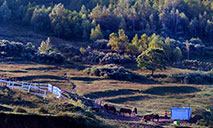Infographics: Five Xinjiang-related falsehoods fabricated by anti-China forces (4)
"Cultural genocide"
Anti-China forces claim that Xinjiang's efforts to promote standard Chinese represent a campaign of "cultural genocide", and that they are a means of "ethnic assimilation", designed to eliminate the spoken and written languages and cultural traditions of ethnic minorities.
The standard language of a country is a symbol of its sovereignty. Every citizen has the right and obligation to learn and use the standard language. This is true not only in China but also in the rest of the world. Learning and using the standard language helps different ethnic groups to communicate, develop and progress.
The Chinese government works hard to promote the use of standard Chinese, but it also protects by law the freedom of ethnic groups to use and develop their own spoken and written languages. China's Education Law prescribes that in ethnic autonomous areas, "schools and other educational institutions dominated by ethnic minority students shall, according to the actual circumstances, use the standard spoken and written Chinese language and the spoken and written languages of their respective ethnicities or the spoken and written language commonly used by the local ethnicities to implement bilingual education".
While carrying out the teaching of standard Chinese, Xinjiang also provides Uygur, Kazak, Kirgiz, Mongolian, Xibe and other language courses at primary and secondary schools, thereby ensuring the right of ethnic minorities to learn and use their own languages and effectively protecting their languages and cultures. Ethnic minority languages are extensively used in such areas as education, judicature, administration and public affairs.
The Chinese government attaches great importance to protecting and developing the best of its traditional ethnic cultures. Xinjiang continues to strengthen the protection and preservation of cultural relics. Six cultural heritage sites, including the Jiaohe Ancient City Ruins and the Kizil Grottoes, have been in the UNESCO World Heritage List; 133, including the Loulan Ancient City Ruins, have been listed as key cultural heritage sites under state protection; and more than 9,000 other fixed cultural relics are well preserved.
Xinjiang has been active in collecting, preserving and rescuing ancient books of all ethnic groups. It has supported the translation and publishing of Kutadgu Bilig (Wisdom of Fortune and Joy), a Uygur masterpiece on the verge of being lost, and has enabled the publication of works of folk literature, including the Mongolian epic Jangar.
The Uygur Muqam and the Kirgiz epic Manas have been registered on the UNESCO Representative List of the Intangible Cultural Heritage of Humanity, and the Uygur Meshrep on the UNESCO List of Intangible Cultural Heritage in Need of Urgent Safeguarding. The region has established four state-level demonstration bases for the preservation of intangible cultural heritage items. They produce ethnic musical instruments, Uygur mulberry paper, Uygur carpets, and Kazak embroidery handicrafts.
Xinjiang embraces cultural diversity and inclusiveness, and upholds mutual learning among cultures. The region fully respects and protects folk traditions, thus realizing the harmonious coexistence of different cultures. Folk festivals are widely celebrated, including the Han Lantern Festival, the Uygur Meshrep, the Kazak Aytes, the Kirgiz Kobuz Ballad Singing Fair, the Mongolian Nadam Fair, and the Hui Hua'er Folk Song Festival.
All of this demonstrates clearly that there is no truth in the accusations of "cultural genocide".
 |  |
Photos
Related Stories
- Tourism helps promote intangible cultural heritage in Xinjiang
- White paper slams fabrications against China's Xinjiang with facts, figures
- Xinjiang's march towards modernization unstoppable: white paper
- Xinjiang's demographic development marks success of healthy population growth of ethnic minorities: white paper
- Xinjiang's "genocide" accusations lay bare hegemonic mindset of anti-China forces: white paper
Copyright © 2021 People's Daily Online. All Rights Reserved.











